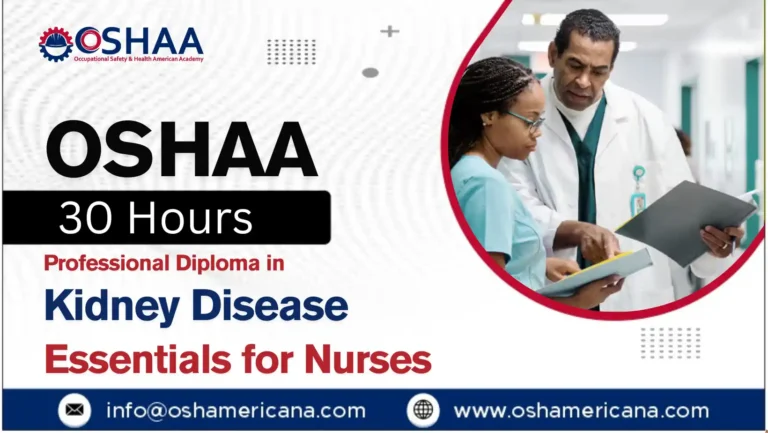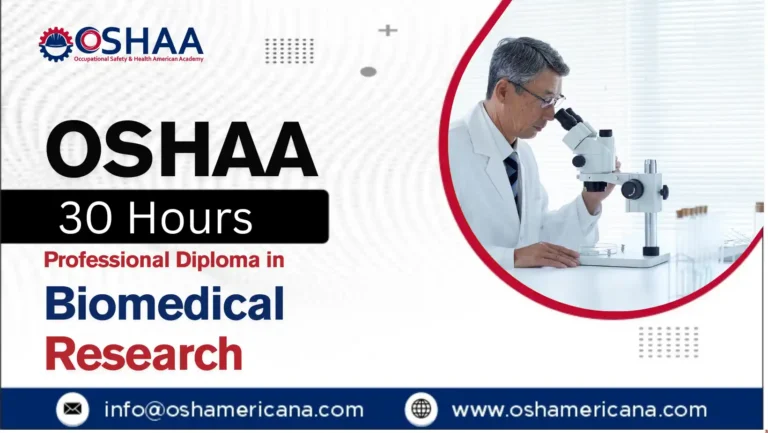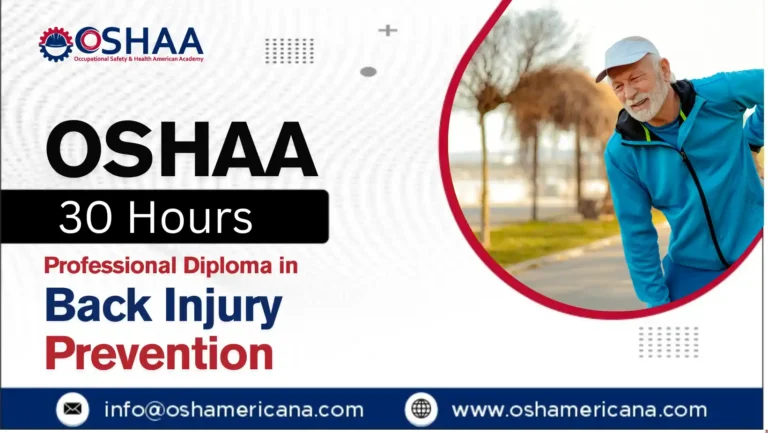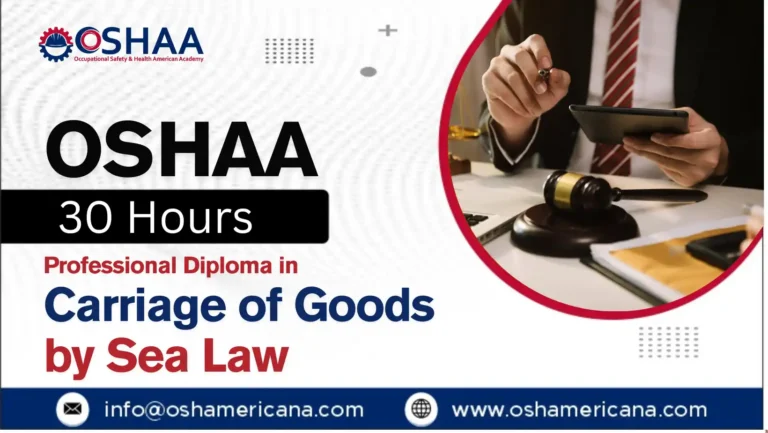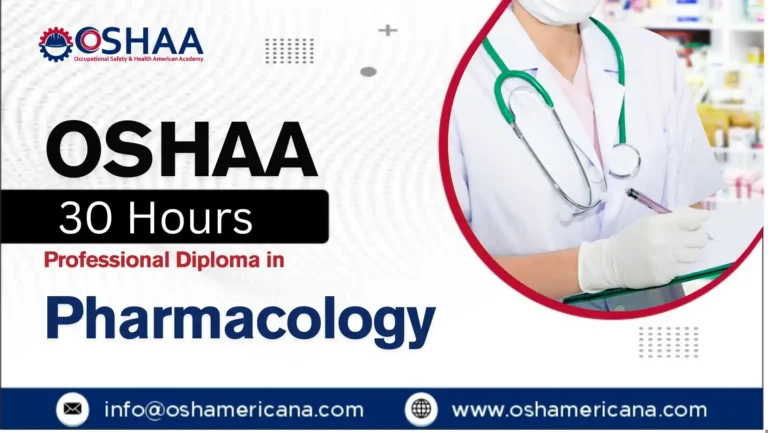Gain essential life-saving skills with the OSHAA 30-Hours Professional Diploma in Basic Life Support (BLS). Master CPR, airway management, and emergency response.
The OSHAA 30-Hours Professional Diploma in Basic Life Support (BLS) is an advanced, professionally accredited training program designed to prepare participants with the knowledge, confidence, and technical skills needed to respond effectively in life-threatening emergencies. In critical moments where every second counts, the ability to perform Basic Life Support can make the difference between survival and loss. This course delivers a comprehensive foundation in essential emergency techniques, ensuring that learners are equipped to handle cardiac arrest, respiratory distress, and other urgent medical situations with competence and precision.
The OSHAA 30-Hours Professional Diploma in Basic Life Support (BLS) focuses on the practical application of life-saving interventions. Participants are trained in cardiopulmonary resuscitation (CPR), airway management, and the proper use of automated external defibrillators (AEDs). These core skills are reinforced through hands-on training, ensuring learners can perform with confidence under pressure. Emphasis is placed on rapid response, effective teamwork in emergencies, and adherence to internationally recognized safety and compliance standards. This structured approach ensures participants gain not only technical expertise but also the ability to remain calm and decisive during high-stress situations.
Cardiac arrest and medical emergencies can occur unexpectedly in any environment, from hospitals and workplaces to public spaces. The OSHAA 30-Hours Professional Diploma in Basic Life Support (BLS) equips healthcare professionals, first responders, caregivers, and individuals from all backgrounds with the ability to provide immediate care that stabilizes patients until advanced medical support arrives. Administering effective BLS within the crucial first minutes of an emergency greatly improves patient outcomes, making this training indispensable for anyone responsible for the safety and well-being of others.
The OSHAA 30-Hours Professional Diploma in Basic Life Support (BLS) also emphasizes compliance with OSHA standards and global health guidelines, ensuring learners understand the importance of professional responsibility, safety protocols, and ethical considerations in emergency care. By completing this program, participants not only gain internationally recognized certification but also strengthen their professional development, enhance employability, and contribute to a safer and more prepared community.
This diploma is more than a training course; it is a vital qualification for individuals committed to health, safety, and emergency preparedness. Whether you are a medical practitioner, a safety officer, a caregiver, or simply someone who wishes to develop the skills to act effectively in an emergency, the OSHAA 30-Hours Professional Diploma in Basic Life Support (BLS) offers the tools and knowledge to save lives. Through comprehensive instruction, hands-on practice, and a focus on compliance and professional excellence, this program prepares learners to act with confidence, competence, and compassion when it matters most.
OSHAA 30-Hours Professional Diploma in Basic Life Support (BLS)
To enroll in the OSHAA 30-Hours Professional Diploma in Basic Life Support (BLS), learners are expected to meet the following criteria. These eligibility requirements ensure that participants are fully prepared to engage with the training program, absorb the technical knowledge provided, and apply the practical life-saving skills with competence. Meeting these standards also guarantees that learners are able to maximize the professional benefits of the OSHAA 30-Hours Professional Diploma in Basic Life Support (BLS) while maintaining compliance with OSHA guidelines and international safety expectations.
- Age Requirement
- Applicants must be at least 18 years of age to enroll in the OSHAA 30-Hours Professional Diploma in Basic Life Support (BLS).
- This minimum age requirement ensures learners have the maturity and responsibility necessary to perform life-saving interventions.
- Candidates who meet the age requirement are more likely to demonstrate the decision-making and composure needed in high-pressure medical emergencies.
- Educational Background
- A minimum of secondary-level education (high school or equivalent) is recommended for admission into the OSHAA 30-Hours Professional Diploma in Basic Life Support (BLS).
- Learners with higher education in healthcare, nursing, or medical sciences are at an advantage, as their background supports faster mastery of technical concepts.
- However, the course is designed to be accessible, and individuals without prior academic specialization can still succeed in acquiring the essential BLS competencies.
- This inclusive approach ensures that the OSHAA 30-Hours Professional Diploma in Basic Life Support (BLS) is open to a wide range of learners seeking professional growth and certification.
- Work Experience
- No prior work experience is strictly required to enroll in the OSHAA 30-Hours Professional Diploma in Basic Life Support (BLS).
- While healthcare workers, first responders, and safety officers will find the training highly relevant to their existing roles, beginners with no background in emergency response can also benefit.
- Having professional experience in healthcare or occupational safety may enhance the learner’s ability to apply techniques more effectively, but the course provides all the necessary foundations for new entrants.
- The OSHAA 30-Hours Professional Diploma in Basic Life Support (BLS) is therefore suitable for both seasoned professionals and those just starting their journey in health and safety training.
- English Proficiency
- Learners enrolling in the OSHAA 30-Hours Professional Diploma in Basic Life Support (BLS) must demonstrate the ability to read, write, and speak English fluently.
- This requirement ensures participants can fully understand the course materials, technical guidelines, and emergency procedures covered in the training.
- Proficiency in English is also vital for complying with OSHA standards and for communicating effectively in real-world emergency situations.
- Strong language skills allow learners to engage actively in hands-on training, interpret medical terminology, and follow global best practices in Basic Life Support.
By meeting these eligibility requirements, participants are well-prepared to succeed in the OSHAA 30-Hours Professional Diploma in Basic Life Support (BLS) and gain the life-saving skills, compliance knowledge, and professional recognition this internationally respected certification provides. This structure ensures that the program remains globally accessible while maintaining high standards of safety, professionalism, and training excellence.
Study Units
Learning Outcomes
The OSHAA 30-Hours Professional Diploma in Basic Life Support (BLS) is designed to provide learners with the essential knowledge, technical expertise, and confidence required to respond effectively to life-threatening medical emergencies. The Learning Outcomes of this program reflect its role in building advanced life-saving skills, OSHA compliance awareness, and leadership in health and safety practices. By mastering each unit, participants in the OSHAA 30-Hours Professional Diploma in Basic Life Support (BLS) gain the ability to perform critical interventions, follow internationally recognized standards, and promote a culture of preparedness in professional and community settings.
- Introduction to Basic Life Support (BLS) (2 Hours)
- Develop a clear understanding of the role and importance of Basic Life Support in emergency medical care.
- Identify the fundamental principles of the OSHAA 30-Hours Professional Diploma in Basic Life Support (BLS) and their application in real-world scenarios.
- Demonstrate awareness of global health and safety standards, including OSHA compliance and international guidelines.
- Recognize the ethical responsibilities of trained responders in providing timely and effective BLS.
- The Chain of Survival (3 Hours)
- Explain the concept of the Chain of Survival and its critical importance in increasing survival rates.
- Identify each link in the Chain of Survival and its role in the continuum of emergency care.
- Apply the Chain of Survival framework within the context of the OSHAA 30-Hours Professional Diploma in Basic Life Support (BLS) training scenarios.
- Evaluate the effectiveness of rapid recognition, early CPR, defibrillation, and advanced care in life-threatening emergencies.
- Cardiopulmonary Resuscitation (CPR) for Adults (4 Hours)
- Perform high-quality adult CPR following international resuscitation guidelines.
- Apply correct chest compression depth, rate, and hand placement techniques to maximize survival chances.
- Integrate CPR protocols into the emergency response procedures outlined in the OSHAA 30-Hours Professional Diploma in Basic Life Support (BLS).
- Develop confidence in handling cardiac arrest emergencies through hands-on practice and simulation.
- CPR for Children and Infants (5 Hours)
- Demonstrate safe and effective CPR techniques tailored specifically for children and infants.
- Recognize the anatomical and physiological differences that influence resuscitation in pediatric patients.
- Apply airway and breathing support methods appropriate for younger age groups in alignment with BLS standards.
- Incorporate pediatric CPR knowledge into the broader emergency response framework of the OSHAA 30-Hours Professional Diploma in Basic Life Support (BLS).
- Airway Management and Breathing Techniques (4 Hours)
- Gain proficiency in identifying airway obstructions and applying appropriate management techniques.
- Use safe and effective breathing support methods, including rescue breaths and bag-mask ventilation.
- Apply airway management strategies within the structured framework of the OSHAA 30-Hours Professional Diploma in Basic Life Support (BLS).
- Understand how proper airway management integrates with CPR and defibrillation for successful patient outcomes.
- Use of Automated External Defibrillators (AEDs) (4 Hours)
- Develop competency in the safe and effective operation of Automated External Defibrillators.
- Understand AED protocols and safety measures in compliance with OSHA and global training standards.
- Apply AED use in conjunction with CPR to deliver comprehensive Basic Life Support during cardiac arrest.
- Build confidence in using defibrillators as part of the hands-on learning in the OSHAA 30-Hours Professional Diploma in Basic Life Support (BLS).
- Choking Emergencies (5 Hours)
- Identify the signs and symptoms of partial and complete airway obstruction in adults, children, and infants.
- Perform effective abdominal thrusts, back blows, and chest compressions to relieve choking.
- Apply emergency choking response techniques across different age groups in alignment with BLS protocols.
- Integrate choking emergency management into the broader training of the OSHAA 30-Hours Professional Diploma in Basic Life Support (BLS).
- Teamwork and Communication in Emergency Situations (3 Hours)
- Develop strong teamwork skills for coordinating with colleagues and responders during critical events.
- Demonstrate effective communication techniques to ensure clarity and efficiency in emergency response.
- Apply leadership principles to guide teams in implementing BLS interventions in high-pressure environments.
- Recognize the importance of collaboration, communication, and structured roles in the OSHAA 30-Hours Professional Diploma in Basic Life Support (BLS).
By completing the OSHAA 30-Hours Professional Diploma in Basic Life Support (BLS), learners acquire not only life-saving technical skills but also the confidence, compliance knowledge, and leadership capabilities necessary to act decisively in emergencies. This program ensures that participants are fully prepared to safeguard lives, maintain global safety standards, and promote a strong culture of health and safety in workplaces and communities. Through mastery of these comprehensive learning outcomes, the OSHAA 30-Hours Professional Diploma in Basic Life Support (BLS) empowers individuals to lead safety initiatives, meet OSHA requirements, and uphold the highest standards of professional emergency care.
The OSHAA 30-Hours Professional Diploma in Basic Life Support (BLS) delivers a wide range of benefits for professionals, organizations, and stakeholders committed to safety, compliance, and life-saving preparedness. This internationally recognized training program ensures participants acquire the advanced competencies required to act confidently in medical emergencies while aligning with OSHA standards and global best practices. By completing the OSHAA 30-Hours Professional Diploma in Basic Life Support (BLS), learners strengthen their professional credibility, enhance workplace safety, and contribute to a culture of preparedness that benefits both individuals and organizations across industries.
- Advanced Life-Saving Skills
- Gain mastery of CPR, airway management, defibrillation, and emergency response through practical, hands-on training.
- Acquire the confidence to act quickly and effectively in cardiac arrest and life-threatening scenarios.
- Strengthen decision-making and rapid response capabilities in alignment with international BLS guidelines.
- Regulatory Compliance and OSHA Standards
- Ensure alignment with OSHA requirements and internationally recognized health and safety protocols.
- Reduce legal risks for organizations by maintaining compliance with regulatory frameworks.
- Demonstrate adherence to global safety standards through the OSHAA 30-Hours Professional Diploma in Basic Life Support (BLS).
- Enhanced Workplace Safety
- Minimize workplace incidents by equipping staff with immediate intervention skills.
- Strengthen organizational safety culture with employees trained in professional Basic Life Support.
- Improve emergency preparedness across industries including healthcare, oil and gas, construction, and corporate environments.
- Professional Development and Career Growth
- Boost employability with a globally recognized certification in Basic Life Support.
- Advance professional qualifications for healthcare providers, first responders, and safety professionals.
- Add a vital credential that enhances career progression opportunities across multiple sectors.
- Cost Savings and Operational Efficiency
- Reduce long-term costs associated with workplace injuries, medical emergencies, and liability.
- Lower insurance risks through proactive compliance with OSHA standards and emergency training.
- Improve response time and outcomes, reducing disruptions to operations.
- Leadership and Communication Skills
- Build strong leadership abilities in managing emergency situations.
- Develop effective communication skills to coordinate emergency responses within teams.
- Enhance the ability to guide and support colleagues during life-saving interventions.
- Global Recognition and Professional Credibility
- Earn an internationally respected certification from the OSHAA 30-Hours Professional Diploma in Basic Life Support (BLS).
- Gain credibility in both local and international job markets.
- Establish a professional reputation for safety, preparedness, and compliance.
- Emergency Preparedness and Risk Reduction
- Learn to identify, assess, and respond to high-risk emergency situations with precision.
- Strengthen organizational resilience against workplace health emergencies.
- Ensure employees and stakeholders are protected through a proactive emergency response framework.
- Confidence in High-Stress Environments
- Train to remain calm and effective during high-pressure emergencies.
- Acquire the ability to take decisive actions that can save lives.
- Develop resilience and self-assurance in unpredictable, real-world scenarios.
- Improved Patient and Worker Outcomes
- Increase survival rates through immediate, high-quality Basic Life Support.
- Reduce long-term medical complications with timely interventions.
- Enhance overall well-being and safety for workers, patients, and communities.
- Teamwork and Collaboration
- Strengthen cooperative skills by working alongside colleagues during emergency drills.
- Foster a collaborative approach to workplace safety and emergency preparedness.
- Build team efficiency with structured emergency response training.
- Innovation and Continuous Improvement
- Stay updated with the latest international BLS techniques and advancements.
- Develop adaptive skills to meet evolving safety and health challenges.
- Contribute to a culture of continuous learning within the workplace.
- Community and Social Responsibility
- Extend life-saving knowledge beyond the workplace into communities and households.
- Empower participants to take responsibility for public safety and welfare.
- Enhance organizational image by investing in socially responsible training initiatives.
By completing the OSHAA 30-Hours Professional Diploma in Basic Life Support (BLS), learners gain far more than technical expertise—they acquire the leadership, confidence, and global recognition required to safeguard lives and foster compliance with international safety standards. This program ensures that participants become trusted professionals capable of making a meaningful impact in both professional and personal environments, supporting organizational safety, global compliance, and sustainable professional growth.
The OSHAA 30-Hours Professional Diploma in Basic Life Support (BLS) is designed for a wide range of learners, including healthcare professionals, safety officers, first responders, industry supervisors, and individuals committed to ensuring workplace and community safety. This globally recognized program is highly relevant for organizations and stakeholders that value compliance with OSHA standards, regulatory requirements, and international best practices in emergency preparedness. By enrolling in the OSHAA 30-Hours Professional Diploma in Basic Life Support (BLS), participants strengthen their professional competencies, gain OSHA-compliant certification, and enhance both individual and organizational capabilities in life-saving response, safety culture, and operational excellence.
- Healthcare Professionals
- Doctors, nurses, and paramedics play a critical role in patient care and emergency response.
- This course ensures they are equipped with the latest CPR, defibrillation, and airway management skills.
- Enhances their ability to act swiftly in cardiac arrest or life-threatening situations.
- Supports compliance with OSHA and international patient safety standards.
- First Responders and Emergency Personnel
- Firefighters, police officers, and rescue workers are often the first to arrive at emergencies.
- The OSHAA 30-Hours Professional Diploma in Basic Life Support (BLS) equips them with critical intervention skills.
- Strengthens their confidence in delivering immediate Basic Life Support during crises.
- Aligns their training with OSHA safety compliance and global emergency response standards.
- Safety Managers and HSE Officers
- Responsible for ensuring compliance with workplace health and safety protocols.
- The course provides in-depth skills to manage emergencies and reduce risks.
- Builds expertise in aligning workplace policies with OSHA standards.
- Enhances overall safety culture and operational performance across industries.
- Operations Supervisors and Team Leaders
- Oversee day-to-day operations where workplace safety and emergency response are critical.
- Gain leadership and coordination skills to manage life-threatening incidents effectively.
- Improve team readiness and ensure OSHA-compliant safety procedures are followed.
- Strengthen organizational resilience by integrating BLS into safety practices.
- Corporate and Industrial Workers
- Employees in industries such as oil and gas, construction, and manufacturing face high-risk environments.
- The OSHAA 30-Hours Professional Diploma in Basic Life Support (BLS) equips them with essential safety response skills.
- Helps reduce workplace incidents and improves overall worker well-being.
- Demonstrates organizational commitment to OSHA compliance and employee safety.
- Educational and Training Professionals
- Teachers, trainers, and school administrators play a key role in student and staff safety.
- The course enhances their ability to respond to medical emergencies in educational settings.
- Provides them with a globally recognized certification in Basic Life Support.
- Ensures compliance with OSHA and institutional safety requirements.
- Community Leaders and Volunteers
- Individuals involved in community programs, NGOs, and social organizations often act as first responders.
- This course equips them with life-saving skills to assist in public emergencies.
- Builds trust within communities by demonstrating readiness to act in crises.
- Promotes compliance with international safety standards for community well-being.
- Caregivers and Support Staff
- Caregivers, home healthcare providers, and support workers often assist vulnerable populations.
- The OSHAA 30-Hours Professional Diploma in Basic Life Support (BLS) ensures they are trained to act in emergencies.
- Enhances their caregiving roles by integrating life-saving interventions.
- Aligns their skills with OSHA and global healthcare safety expectations.
- Students and Aspiring Professionals
- Ideal for individuals preparing for careers in healthcare, safety, or emergency services.
- Provides a strong foundation in Basic Life Support techniques and safety compliance.
- Builds confidence and employability with an internationally recognized qualification.
- Positions learners as valuable assets in OSHA-regulated industries.
- Organizations and Employers
- Companies across industries benefit by having OSHA-trained employees on-site.
- Enhances organizational compliance with safety regulations and reduces liability.
- Improves emergency preparedness, ensuring employee and stakeholder safety.
- Strengthens brand reputation by demonstrating commitment to workplace safety and compliance.
The OSHAA 30-Hours Professional Diploma in Basic Life Support (BLS) is not just a training program but a globally recognized certification that equips professionals across industries with the advanced knowledge, life-saving skills, and compliance expertise needed to lead safety initiatives. By completing this program, participants and organizations gain the tools to improve safety standards, ensure OSHA compliance, and foster operational excellence in any environment.


